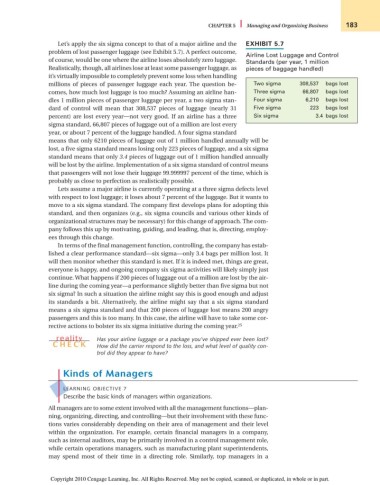Page 209 - Introduction to Business
P. 209
CHAPTER 5 Managing and Organizing Business 183
Let’s apply the six sigma concept to that of a major airline and the EXHIBIT 5.7
problem of lost passenger luggage (see Exhibit 5.7). A perfect outcome,
Airline Lost Luggage and Control
of course, would be one where the airline loses absolutely zero luggage. Standards (per year, 1 million
Realistically, though, all airlines lose at least some passenger luggage, as pieces of baggage handled)
it’s virtually impossible to completely prevent some loss when handling
millions of pieces of passenger luggage each year. The question be- Two sigma 308,537 bags lost
comes, how much lost luggage is too much? Assuming an airline han- Three sigma 66,807 bags lost
dles 1 million pieces of passenger luggage per year, a two sigma stan- Four sigma 6,210 bags lost
dard of control will mean that 308,537 pieces of luggage (nearly 31 Five sigma 223 bags lost
percent) are lost every year—not very good. If an airline has a three Six sigma 3.4 bags lost
sigma standard, 66,807 pieces of luggage out of a million are lost every
year, or about 7 percent of the luggage handled. A four sigma standard
means that only 6210 pieces of luggage out of 1 million handled annually will be
lost, a five sigma standard means losing only 223 pieces of luggage, and a six sigma
standard means that only 3.4 pieces of luggage out of 1 million handled annually
will be lost by the airline. Implementation of a six sigma standard of control means
that passengers will not lose their luggage 99.999997 percent of the time, which is
probably as close to perfection as realistically possible.
Lets assume a major airline is currently operating at a three sigma defects level
with respect to lost luggage; it loses about 7 percent of the luggage. But it wants to
move to a six sigma standard. The company first develops plans for adopting this
standard, and then organizes (e.g., six sigma councils and various other kinds of
organizational structures may be necessary) for this change of approach. The com-
pany follows this up by motivating, guiding, and leading, that is, directing, employ-
ees through this change.
In terms of the final management function, controlling, the company has estab-
lished a clear performance standard—six sigma—only 3.4 bags per million lost. It
will then monitor whether this standard is met. If it is indeed met, things are great,
everyone is happy, and ongoing company six sigma activities will likely simply just
continue. What happens if 200 pieces of luggage out of a million are lost by the air-
line during the coming year—a performance slightly better than five sigma but not
six sigma? In such a situation the airline might say this is good enough and adjust
its standards a bit. Alternatively, the airline might say that a six sigma standard
means a six sigma standard and that 200 pieces of luggage lost means 200 angry
passengers and this is too many. In this case, the airline will have to take some cor-
rective actions to bolster its six sigma initiative during the coming year. 25
reality Has your airline luggage or a package you’ve shipped ever been lost?
CH ECK How did the carrier respond to the loss, and what level of quality con-
trol did they appear to have?
Kinds of Managers
LEARNING OBJECTIVE 7
Describe the basic kinds of managers within organizations.
All managers are to some extent involved with all the management functions—plan-
ning, organizing, directing, and controlling—but their involvement with these func-
tions varies considerably depending on their area of management and their level
within the organization. For example, certain financial managers in a company,
such as internal auditors, may be primarily involved in a control management role,
while certain operations managers, such as manufacturing plant superintendents,
may spend most of their time in a directing role. Similarly, top managers in a
Copyright 2010 Cengage Learning, Inc. All Rights Reserved. May not be copied, scanned, or duplicated, in whole or in part.

